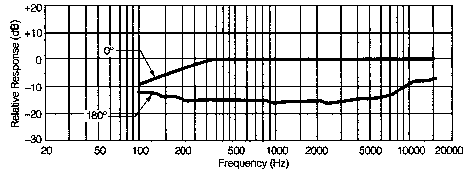|
|
Unidirectional floor microphone
- electronics -
20130302 20130510 +PD
F 20231117 pa0nhc |

Linedriver schematic. Click-right to download.
PDF
NB: if C1,2 cannot be paired, use 10uF (wet) elco's instead (- connected to R1/2).
The WM-55A103 is a 9.7mm high quality cardioids back electrets capsule, suitable for this PCC directional microphone.
20231117 : A similar microphone cell for the WM-55A103
seems to be CMI-5247TF-K .
The WM-61A is a 6mm omni back electrets capsule, suitable for the L2-stereo-array
(elsewhere on this site).
The older (obsolete) WM-55 and WM-61 capsules are NOT back electret, and have a LESS flat frequency response (+6dB peak around
8kHz).
Wide and flat frequency response.
The WM-55A103 capsule was chosen here for its very flat (neutral) mid- and high frequency response, not to high sensitivity, and low noise level.
Like most (small diameter) electrets cardioids microphones, the frequency characteristic of the WM-55A shows a low frequency roll-off. For this
electrets element it is 6dB/octave below 250Hz (-3 @ 250, -9 @ 100, -15 @ 50Hz).
For most recording purposes, in practice this can easily be compensated during recording, simply using the mixers EQlow set at a
position of ca. 15:00 - 16:00 Hrs. Or afterwards in the PC during edit, using FFT in the audio software.
High quality recordings of classical performances are possible.
Due to the excellent balancing effect of my linedriver design, 50 Hz cable induced hum will never be a problem, even with the mentioned EQ of 15dB @
50Hz.
Sensitivity.
Using a drain resistor of only 680 ohms, Panasonic states a sensitivity of -47dBv/Pa +- 4dB for this WM-55A103
capsule in free air.
Whith a 2k2 drain resistor, the output (sensitivity) rises with 10dB.
Adding a 2k2 source resistor, 10dB negative feedback is introduced. This reduces distortion in the capsules internal FET at high sound levels.
The output on R1 is reduced 10dB too, resulting in 0dB gain.
With the combined (balanced) output from both R1 + R2, the sensitivity rises by 6dB.
The total sensitivity now with the capsule in free air is calculated to -41dBv/Pa +-4dB (-47 + 0 + 6
dB).
Used as a PCC (by placing the capsule directly on top of a big, flat and hard surface), results in a acoustical gain of
6dB only for direct sound. This improves the S/N by 6dB !! (see Crown publication part "PCC").
The practical sensitivity as a PCC now becomes -35dBv/Pa +-4dB.
Max spl.
The drain current of the capsules internal FET was ca. 0,35mA. It cannot be changed.
The resulting max. voltage swing over the source resistor + drain resistor combined (at begin of flat topping) is therefore 2x (2x 0,35mApp x 2,2kOhm) = 3,08 Vpp = 1,2 Vrms =
+1dBv.
The max. loudness for this capsule with the system used as a PCC (placed on a large hard plane) is calculated to 130 dBspl +- 4dB
(94dBspl + (35db + 1dB)).
My design shows 10 dB better max.SPL than an expensive professional stage floor microphone from a well
known brand, and most cheap commercial electret microphones.

